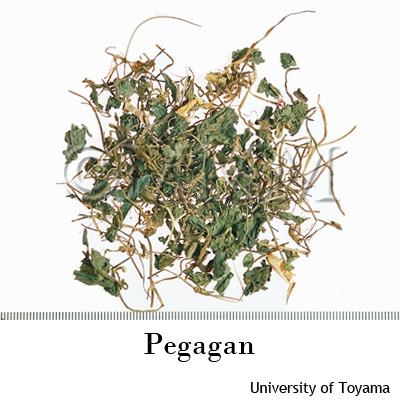Crude drug sample data base
※Click on the image to enlarge it.
The capital city, provincial capital city or the representative
location of its administrative area is indicated.
location of its administrative area is indicated.
Production area information
https://ethmed.toyama-wakan.net/img/pin_san.png
-6.9174639
107.61912280000001
Collection information
Republic of Indonesia,West Java Province
https://ethmed.toyama-wakan.net/img/pin_nyu.png
Scientific information data base
| Crude drug name | Indonesian name, English name | Daun kaki kuda | ||||
|---|---|---|---|---|---|---|
| Synonyms | Pegagan | |||||
| crude drug image |
| |||||
| Original plant name | Centella asiatica (L.) Urban syn. Hydrocotyle asiatica Linn. | |||||
| Family name | Umbelliferae | |||||
| Used part | Aerial part | |||||
| Distribution area | It is distributed in pantropical areas including South-East Asia and extending into some subtropical regions. It occurs in east part of Java Island (Indonesia) from sea level up to 2500 m altitude. It grows in slightly shaded, damp localities on fertile soils [201, 205]. | |||||
| Description | A perennial herb creeping with long stolons (up to 23.5 m long), rooting at the nodes. Leaves in rosettes, lamina orbicularis-reniform, 1-7 cm in diameter, crenate or crenate-dentate, palmately veined, subglabrous; petiole 1-40 cm long, broadened at the base into a leaf-sheath. Inflorescence an axillary simple umbel, bisexual, 5-merous;calyx obsolete [205]. | |||||
| Drug effect | Sweet, cooling, blood cleanser, improve blood circulation [231]. | |||||
| Specific actions | Antipyretic, diaphoretic, diuretic, anti infective [231]. | |||||
| Frequency in use | Moderate. | |||||
| Common uses | Pegagan is a relished vegetable in some parts of Java Island of Indonesia. It is bitter and eaten raw or cooked [201, 205]. | |||||
| Pharmacological effect | Study to evaluate the wound-healing potential of the ethanolic extract of Centella asiatica in both normal and dexamethasone-suppressed wound healing showed that the leaf extract promotes wound healing significantly and is able to overcome the wound-healing suppressing action of dexamethasone in a rat model [PMID: 16928669]. Investigation of an interaction between orally givenCentella asiatica's ethyl acetate fraction (EACA) and intraperitoneally administered antiepileptic drugs suggested a potential of Centella asiatica to be developed as an adjunctive medication for epileptic patients [PMID: 16858951]. Study aimed to evaluate the efficacy of Centella asiatica on the mitochondrial enzymes; mitochondrial antioxidant status in adriamycin induced myocardial injury. Elevated oxidative stress and mitochondrial dysfunction in adriamycin treated rats concluded that the aqueous extract not only possesses antioxidant properties but it may also reduce the extent of mitochondrial damage [PMID: 16786185]. | |||||
| Medical system | Indonesian medicine (Jamu) | |||||
| Traditional usage | It is considered a plant that represents a pharmacy because of its health benefits. The plant is a diuretic and diaphoretic. Decoction of all parts is used as blood purifier, cholagogue, haemorrhoids/hemorrhoids, whooping cough, nose bleeding in children. Infusion of leaves is for leprosy, syphilis, fever, asthma, sore throat, fluor albus, kidney stones and other kidney diseases, mouth ulcer as a mouth wash. Sap from the root is heated and put on the leaves and the leaves are used to cover the wounds. Sap is applied alone or in combination with other vegetables to treat stomach ache and worm infestations in children. Fresh leaves are used to cure small new wounds. Dried leaves in powdered form are for cold and whooping cough. Crushed leaves are successfully useful in treating skin inflammation. Treatment of bruises by covering the affected area with leaves [201]. | |||||
| Formulation | 1) Asthma and expectorant: 2 handful of aerial parts of C. asiatica is pounded with water, squeezed to obtain the juice. Drink 1/4 cup of the juice once a day for 14 days [231]. 2) Peptic ulcer and dysentery: 2 handful of aerial parts of C. asiatica, 1 (size of an adult finger) fresh rhizome of turmeric, 1 teaspoon of thallus of Usnea misaminensis (Usnea sp.), 9 pieces of fruits of Coriandrum sativum and 110 ml. of water. Boil the mixture to make a decoction. Drink 100 ml of the decoction once a day for 7 days [231]. | |||||
| References | Reference book Tips! | [201] K. Heyne, Tumbuhan Berguna Indonesia, Vols. 1-4, 1987. Diedarkan Oleh Koperasi Karyawan Departemen Kehutanan, Jakarta, Indonesia. Vol. 3, pp 1545-1546. [205] de Pdua, L.S., Bunyapraphatsara, N. and Lemmens, R.H.M.J. (Editors), 1990. Plant Resources of South-East Asia No. 12 (1). Medicinal and poisonous plants 1. Backhuys Publishers, Leiden, Netherlands. pp 190-194. [208] Setiawan Dalimartha. Atlas Tumbuhan Obat Indonesia, Vol. 1 (1999), Vol. 2 (2000), Vol. 3 (2003). Trubus Agriwodya, Jakarta, Indonesia. Vol. 2, pp 151-153. [231] Soedibyo, Mooryati: Alam Sumber Kesehatan: Manfaat dan Kegunaan (Natural resources for health. Benefits and uses). Balai Pustaka. 1998. pp 295-296. | ||||
| Research paper | 1. Shetty BS, Udupa SL, Udupa AL, Somayaji SN. Effect of Centella asiatica L (Umbelliferae) on normal and dexamethasone-suppressed wound healing in Wistar Albino rats. Int J Low Extrem Wounds. 5(3):137-43, 2006. (PMID: 16928669) 2. Vattanajun A, Watanabe H, Tantisira MH, Tantisira B. Isobolographically additive anticonvulsant activity between Centella asiatica's ethyl acetate fraction and some antiepileptic drugs. J Med Assoc Thai. 88 Suppl 3:S131-40, 2005. (PMID: 16858951) 3. Gnanapragasam A, Yogeeta S, Subhashini R, Ebenezar KK, Sathish V, Devaki T. Adriamycin induced myocardial failure in rats: protective role of Centella asiatica. Mol Cell Biochem. 294(1-2):55-63, 2007. (PMID: 16786185) | |||||
| Remarks | Asiatic pennywort is very popular worldwide for its action in skin-related diseases. The main constituent asiaticoside is famous of its antileprosy property [205]. Although seems related, C. asiatica differs morphologically with Hydrocotyle species [205]. | |||||
| Last renewal date | 2024/03/04 | |||||






